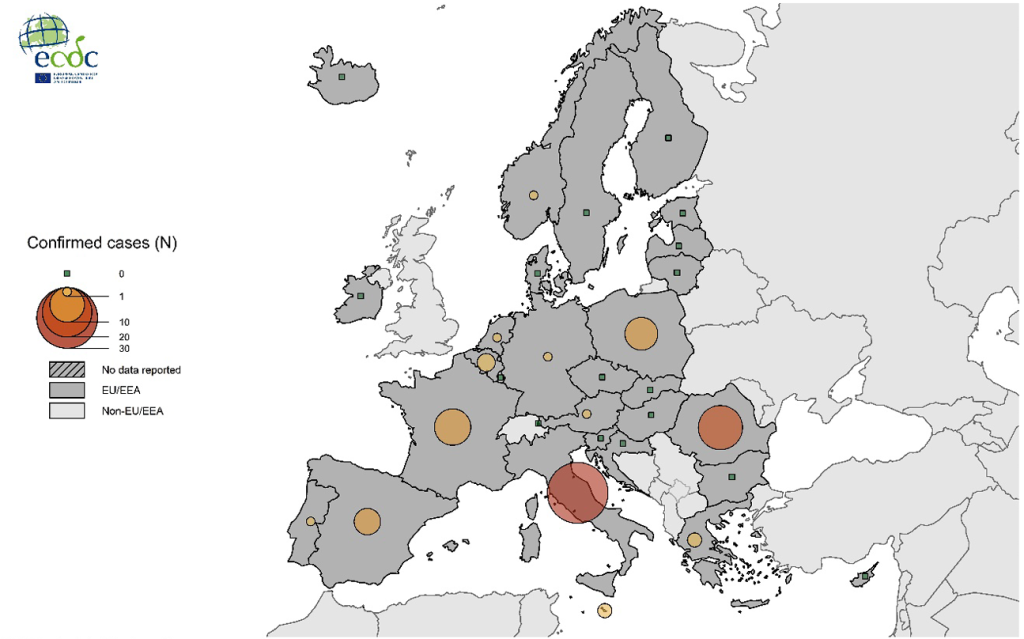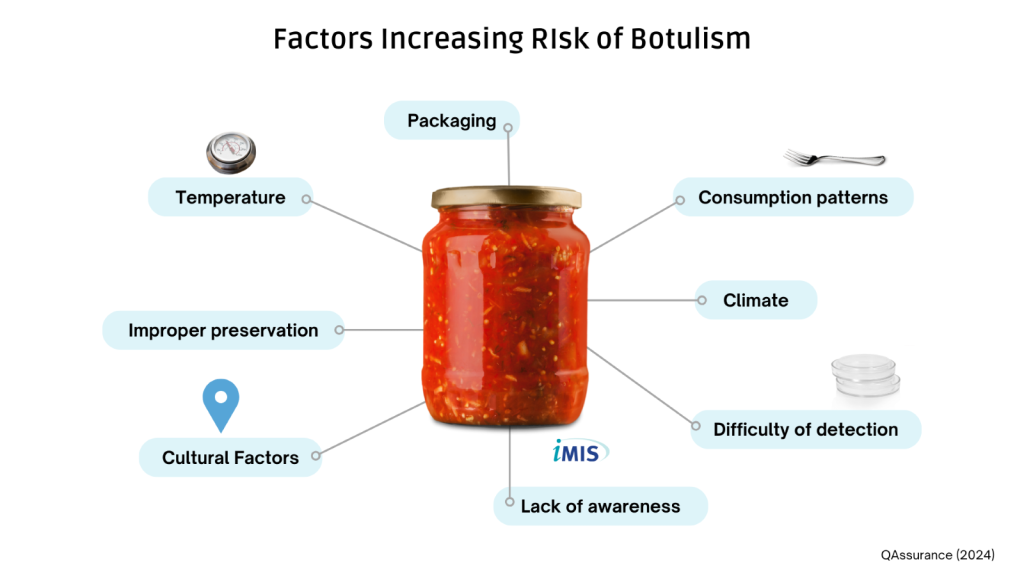Introduction
Botulism, a severe and potentially fatal illness caused by a potent neurotoxin, is experiencing a concerning resurgence in Europe, particularly in southern regions. Despite it being considered rare, recent outbreaks have highlighted the need for increased awareness and proactive prevention strategies.
This article delves into the causes behind this resurgence, explores the factors contributing to its prevalence in certain areas, and outlines the steps that individuals, food safety authorities, and the food industry can take to combat this silent threat.
Understanding Botulism
Botulism is caused by the bacterium Clostridium botulinum, which produces a neurotoxin that disrupts nerve function, leading to muscle paralysis. Symptoms typically appear 12 to 36 hours after ingesting contaminated food and can include:
- Blurred vision
- Difficulty swallowing
- Muscle weakness
- Facial paralysis
- Respiratory failure
-> In severe cases, botulism can be fatal if not treated promptly with antitoxin.
Recent Trends
While botulism remains relatively rare, recent data and news reports suggest a concerning trend in Europe. In 2022, the EU saw 84 reported cases, a slight increase from 2021, with Malta, Romania, and Italy reporting the highest incidence (Fig.1). Though caused by the second most frequent bacterial toxin in foodborne outbreaks, Clostridium botulinum was responsible for the second highest number of hospitalizations and deaths. Infants were the most affected age group, highlighting the need for vigilance.
While official data for 2023 and 2024 is pending, various news reports indicate ongoing outbreaks, underscoring the importance of public awareness and robust food safety practices.

Relevant Recent Botulism Outbreaks
Recent outbreaks across Europe highlight the ongoing risk posed by this severe illness and underscore the need for continued vigilance in food safety practices. Here are some notable incidents that have garnered attention:
- September 2023, France: An outbreak in Bordeaux was linked to canned sardines consumed at a restaurant, raising concerns about commercially canned products.
- September 2024, France: Five people were hospitalized after consuming homemade jarred pesto, emphasizing the importance of proper home preservation techniques.
- October 2024, Italy: A woman in Italy died after consuming supermarket soup that was likely improperly stored at home, highlighting the crucial role of consumer awareness and safe food handling.
Botulism, a growing concern?
Several factors may have contributed to the recent cases of botulism cases in Europe (Fig.2):
- Changing Food Consumption Patterns: There’s a growing trend towards consuming artisanal, homemade, and traditionally preserved foods. While these foods offer unique flavors and cultural experiences, they can pose a higher risk if not prepared with strict adherence to safety guidelines.
- Lack of awareness: A lack of awareness about safe food handling and preservation practices, particularly among younger generations or those new to home food preservation, can increase the risk of botulism.
- Globalization and Food Imports: The increased movement of food products across borders can introduce new strains of C. botulinum and potentially contaminated foods into different regions.
- Climate Change: Changes in temperature and environmental conditions may influence the growth and survival of C. botulinum spores, potentially increasing the risk of contamination in certain areas.
The Southern European Context
Southern European countries, with their rich culinary traditions and reliance on home food preservation methods, appear to be particularly vulnerable to botulism outbreaks. Factors contributing to this include:
- Cultural Practices: Traditional methods of preserving foods, such as homemade sausages, cured meats, and preserved vegetables, if not performed with meticulous care, can create an environment conducive to C. botulinum growth.
- Climate: Warmer temperatures in Southern Europe may favor the growth and survival of C. botulinum spores.

Prevention Strategies: A Multi-pronged Approach
Combating botulism requires a concerted effort from individuals, food safety authorities, and the food industry.
Individual Precautions:
- Education: Learn about safe food handling and preservation practices, particularly when canning or preserving food at home.
- Hygiene: Maintain strict hygiene when preparing food, including thorough handwashing and proper cleaning of utensils and surfaces.
- Safe Canning: Follow established guidelines for safe canning and preserving, including careful sterilization and processing of low-acid foods.
- Avoid Suspicious Foods: Do not consume food from bulging or damaged cans or jars, or any food that looks or smells unusual.
Food Safety Authority Actions and Food Industry Responsabilities:
- Surveillance and Monitoring: Strengthen surveillance systems to detect and investigate cases promptly.
- Public Awareness Campaigns: Conduct public awareness campaigns to educate consumers about risks and prevention strategies
- Regulation and Enforcement: Enforce strict food safety regulations and standards for food businesses, particularly those involved in canning and preserving.
- Collaboration: Foster collaboration with healthcare providers to ensure rapid diagnosis and treatment of cases
- Traceability: Implement effective traceability systems to track products throughout the supply chain and facilitate rapid recall in case of contamination.
- Innovation: Invest in research and development of new technologies and preservation methods that minimize the risk of botulism.
The Importance of Supplier Trust and Traceability
In the fight against botulism, trust in your suppliers and robust traceability systems are essential. Suppliers provide the foundation of your products, so ensuring their adherence to safety standards is key to minimizing contamination risk. Traceability allows you to track ingredients throughout the supply chain, enabling quick identification of potential contamination sources and targeted risk mitigation.
-> Building strong supplier relationships based on transparency and open communication is crucial for a safer, more resilient food system.
Conclusion
Botulism still causes problems in Europe, particularly in southern regions, and is a serious public health concern. By understanding the factors contributing to this trend and implementing comprehensive prevention strategies, individuals, food safety authorities, and the food industry can work together to combat this silent threat and protect public health.
Stay Connected: Join our Newsletter!
Ready to learn more? Subscribe to our newsletter for the latest updates, tips, and exclusive content delivered straight to your inbox!
Sources
- European Centre for Disease Prevention and Control. (2022). Botulism. https://www.ecdc.europa.eu/en/botulism
- European Centre for Disease Prevention and Control. (2024). Botulism. In Annual Epidemiological Report for 2022. Stockholm: ECDC. https://www.ecdc.europa.eu/en/publications-data/botulism-annual-epidemiological-report-2022
- Eurosurveillance Editorial Team. (2023). Outbreak of b0tulism linked to consumption of commercially canned sardines, France, September 2023. Eurosurveillance, 28(47), 2300624.
- Euronews. (2024, September 16). B0tulism led to 5 people being hospitalised in France: What is it and how can you avoid it? https://www.euronews.com/health/2024/09/16/botulism-led-to-5-people-being-hospitalised-in-france-what-is-it-and-how-can-you-avoid-it
- Medscape Medical News. (2024). B0tulism Outbreaks in Europe Raise Food Safety Concerns. https://www.medscape.com/viewarticle/botulism-outbreaks-europe-raise-food-safety-concerns-2024a1000kf5?form=fpf
Related articles to Botulism Cases in Europe: What You Need to Know
Many customers and visitors to this page 'Botulism Cases in Europe: What You Need to Know' also viewed the articles and manuals listed below:
